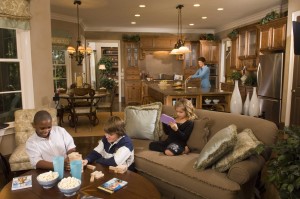I’ve made some new (parasocial) friends.
My Canadian pals include income property expert Scott McGillivray, fixer-upper angels Drew and Jonathan Scott, designer & realtor nemeses Hilary Farr & David Visentin + (their junior counterparts) Jillian Harris & Todd Talbot, and even Type A reno maven Candice Olson. In Minneapolis, I’ve got my girls Nicole Curtis and Amy Matthews who absolutely rule. In LA, there’s home-makeover fashionista Sabrino Soto, real estate gurus Josh Flagg, Josh Altman, and Madison Hildebrand, and perfection stager Meridith Baer. Cuddly cousins Anthony Carrino and John Colaneri make housecalls in Jersey, David Bromstad keeps it colorful in Miami, Egypt Sherrod assists property virgins in Atlanta, Allison Victoria crashes Midwestern kitchens, and house hunters troll the country (and overseas) for turnkey bargains.
Clearly, I’ve got quite the social life.
When a debilitating cold couched my body but skirted my mind, I was in prime condition for (over)analyzing HGTV.
I’m thinking about if/how American parents’ belief in surveillance has influenced residential architecture and home purchases, specifically in favor of the “open concept.” Do parents really need unwalled kitchens so they can always see their kids in the living room? Talk to me.
I posted that status update to Facebook, a condensed version of this URL + comment I’d posted a few moments earlier:
Love this: “They [Japanese people] like for the children to spend a lot of time with each other with minimal adult intervention so that they can learn how to get along with each other. …children deserve a childhood where they’re able to walk around and have fewer adult eyes on them every moment, then really things can change. Parents can feel that trust in their children.”
Similar sentiments were voiced by a preschool teacher in Norway (not the nature barnehage, a teacher at a conventional preschool). They had a room that was ONLY KIDS ALLOWED, like a clubhouse, because they believe that kids need some time to themselves. In American preschools, there are no doors on bathrooms because teachers need to be able to see kids at all times (and, due to fear of predation, adults are never allowed to be alone with children at any time).
So I’m thinking about if/how American parents’ belief in surveillance has influenced residential architecture and home purchases, specifically in favor of the “open concept.” Parents (usually moms) claim that they need unwalled kitchens so they can see their young children in the living room. How much time do they spend in the kitchen, and why is this chiefly the woman’s concern? What would happen if their eyes were off the kids during their kitchen time? How might lack of privacy and the unimpeded carrying of noise adversely affect familial relationships or activities? Talk to me.
I tipped my biased hand by trotting out the term “surveillance,” which hardly has neutral connotations. It’s a credit to my FB friends that they didn’t totally bristle at this, and I’ll share their insightful comments a little bit later. But before we examine what my friends taught me, I’d like to explain my interests in child-rearing, home design, and surveillance.
My Background
During the spring of 2002, I observed and interviewed educators at several early childhood education and care (ECEC) establishments in eastern Norway, Paris, and Chicago. While my objective was to investigate dimensions of educating vs. caregiving, I couldn’t help but notice how different laws and philosophies influenced the activities of teachers and students alike. From 2003-2006, I had the great good fortune of working in ECEC at The Open Center for Children, Harvard Yard Child Care Center, and The Eliot-Pearson Children’s School; I also regularly visited my best friend Jenn at Garden Nursery School.
In 2008, I began my doctoral studies in Communication at the University of Southern California‘s Annenberg School for Communication and Journalism. Two years later, as a student in IML 501: Digital Media Workshop, I worked with a couple of phenomenal classmates to record a satirical video about ceaselessly measuring and surveilling young children. We designed our video in order to hyperbolically emphasize both the ridiculousness of unremitting assessment and the toll it exacts in the form of overstressed parents and burned-out children. We argued that such a joyless, goal-oriented approach to life and learning, as well as its accompanying usurpation of the free time necessary for developing sensory, social, and emotional skills, may significantly hinder children’s capacity to negotiate in-school and out-of-school challenges.
For three weeks during the summer of 2011, I co-taught two classes of children (aged 5-7 years old and 7-9 years old, respectively) enrolled in a private enrichment program in Mumbai, India. A huge part of the job was educating my privileged students’ wealthy parents. From Monday through Friday, I wrote each class’s daily newsletter for distribution to the parent listserv. Not only did I enumerate our activities, I also explained how the children’s work facilitated their development of fine motor, gross motor, pre-literacy, pre-math, and social and emotional capacities. At the end of each week, we hosted an Open House for parents. I would narrate our slideshow of classroom images, again demystifying the connections between Activity X and Learning/Developmental Goal Y. Then my co-teachers and I would invite parents to both peruse their children’s products and recreate an art project/science experiment. We struggled to strike a balance between keeping parents convinced of the program’s “value-add” and keeping students engaged with projects of value.
The following fall, I was a Teaching Assistant for COMM 395: Gender, Media & Communication. From Dr. Alison Trope, I learned about Foucault’s theory of the panopticon (and then turned around and taught it to my students). Literally, a panopticon is a round, windowed guard tower in a prison yard; from it, rifle-aiming overseers can surveil inmates at all times while inmates never know if/when/who is watching. Foucault reviews societal institutions such as schools, factories, and hospitals and identifies “panopticons” in those environments — sites from which people in power can observe/control subject populations.
Today, I study and design pedagogy that endeavors to teach the whole child; dote on the children of pals and passersby; think about children’s toys and leashes and media and meaning-making; and yearn for (the right time when I can have) children of my own. Two weeks ago, I visited ECEC exemplar Stock School and the autonomy-supportive Chicago Quest Schools. Inspired by a recent in-flight conversation with a Swedish seatmate and friends’ posts of an article + a documentary about “forest kindergartens” (operational in Norway and Switzerland, among other places), I’ve lately been reflecting on European child-rearing. And also, don’t forget, I watch a lot of HGTV, especially since I got that pesky cold.
Research Questions
On most HGTV shows, the high-maintenance home seekers want “open concept” floor plans and rule properties/plans in or out of consideration according to this criterion. So, the Property Brothers, Love It or List It’ers, and other patron saints of home renovation blow out walls, install header beams, and design spaces in order to accommodate this “open concept” craving. Collectively, this adds up to a whole mountain of money.
And why? I hear a lot of parents on these shows claim that they need “open concept” because they have to supervise their children. And I wonder, Do you really _need_ to supervise your children? What happens if you don’t supervise — will the kids REALLY get into life-or-death situations and/or incorrigible patterns of danger-making? What happens if you do supervise — will the kids never learn how to self-monitor and/or entertain themselves?
I also hear parents contend that they entertain a lot, and I wonder what “a lot” means. How frequently do they really have people over, and to what extent should these occasional visits dictate how the house functions on all of the other days of the year?
So that’s how I got from “open concept” floor plans to parenting to panopticons. And now that you know the context, you might very well ask how I could have done otherwise.
Methods
From my two FB postings, I welcomed 20 fascinating comments from 13 friends (Jen, Christine, Grace, Sara, Mike, Diana, Melissa, Marci, Joy, Lauren, Mallory, Liz, Aylin), and also contributed to the conversations eight times in order to clarify, query, and/or share. Here are a few of my comments:
I remember when we were older — maybe it was when my brother was 14, that would make me 10 — my brother and I would be bothered by the light and noise coming from our mom in the kitchen because it interfered with our easy TV watching (poor us, right? anyway). So Benjy figured out that if he opened a storage closet door, it would block our sightline of the kitchen and help a bit with the light and noise… And so I wonder what happens when kids grow up in these homes — do these issues cause them to retreat even further, like to basements or bedrooms, foiling the “all together” rationale of open concept? Is that just a normal part of adolescence? Is open concept really about getting a grand room and not about “all together”?
and
I guess I just wonder about how often kids will get into unsafe stuff during food prep time, and I wonder about the consequences if/when they do. Is the frequency and/or intensity of either enough to justify expensive choices, and potential incursions into privacy? I also wonder if non-catastrophic consequences — like, a child gets a booboo — provide opportunities for learning about cause-and-effect and ultimately, self-regulation and self-efficacy. We all know, I DON’T HAVE KIDS and I’m an egghead for a living, so enlighten me, debate me. I’m just, as the pretentious call it, problematizing… Thank you, friends :)
I also did a very wee bit of online research (Brunner, 2013; Hillukka, 2012) and continued to consume HGTV programming in gluttonous proportions.
Results
From these data, I identified opportunities related to “open concept” vs. “traditional” floor plans in terms of three areas:
-
Sensory Access
-
Proximity
-
Lifestyle
Attached to each opportunity are considerations for “everyday” and “entertaining.” I cite the arguments (e.g., raw data) that support each perspective directly beneath them. I purposely leave my judgmental frame behind, instead using positive terms to describe the affordances and assumptions that come with each floor plan. This is not a table of pro’s vs. con’s; it is an inventory of pro’s and pro’s.
1A. Sensory Access (Sight, Sound, Temp) – Everyday:
- OPEN CONCEPT: Monitoring safety, Lighting multiple rooms from common set of windows, Circulating sound from multiple rooms (e.g., children’s fighting, crying, querying), Universal heating/cooling
Diana: “Parents want to make sure their kids aren’t doing anything unsafe while the parent is trying to cook dinner.”
Melissa: “Right now, I wouldn’t be able to cook dinner if I couldn’t see my kids while I was cooking. Little ones are always getting into something. Not sure the open concept will be as important when they are a little older.”
Marci: “Also now that I have a boy, I have a new appreciation for how quickly a little one can get themselves into trouble. Lucy was easy peasy; James ends up on the coffee table ready to go over the edge in seconds and bruises and head bumps do not deter him – he’s an animal and totally born to be a running back.”
Marci: “In a world where even Lucy watches tv while on my iPhone with 3 other people in the room doing their own thing, I think your ability to hear changes for better or worse”
Hillukka, 2012: “You can also watch the little ones play while you are cooking or working in another room. Finally, an open concept allows more natural light into every room, making the entire area seem more spacious and welcoming.”
- TRADITIONAL: Facilitating autonomy, Lighting each room from each set of windows, Creating sound barriers between rooms (e.g., TV in living room, food processor in kitchen), Specific heating/cooling
Liz: “the mirror on the wall to see into the living room from my place at the kitchen table works perfectly well. it has been there at least 25 years. i’m also a firm believer in “if it’s too quiet something is up.” especially having been the one making too little noise during childhood.”
Aylin: “dear laurel. hi. i am totally with you that kids need their own time and space to play.”
Jen: I absolutely agree with your thoughts on this, Laurel. American anxieties regularly interfere with play (is my child being bullied? is my child not talking enough? too much?) making it hard for kids to practice resolving things on their own. Honestly, this is one of the reasons we opted for a house without and open floor plan (that and cost–because nobody wants them!).”
Christine: “Very interesting to think about. I have a 5 and 3 year old (and one due any day now). I think what happens is that children’s abilities evolve so gradually, and parents don’t always see that growth because they’re in it every day. Parents may not realize their children can be trusted with the next level of difficulty. Also, I think our generation of parents prioritizes eliminating pain/suffering for our children and will go to great lengths (home construction, surrender of privacy, etc) to control their environment. It is physically and emotionally exhausting to try to keep this up for any length of time. We have tried to settle into a more comfortable style of mitigating risks so the kids can play unsupervised (we have a fence, we removed saws from the basement play area). It is so satisfying to hear the kids playing independently. We’re all having a lot more fun.”
Grace: “I remember childhood as a non-chaperoned experience. My parents were there but they would not have known to intervene unless we asked them to. They weren’t poor parents – they were parents in the 60’s and 70’s.
Today we have a number of issues that make this ideal difficult. -Heavily scheduled young kids. -Childcare – my nanny job often entails entertaining and daycare has a schedule to follow. When would most young children be able to experience this and living in America today – how would we facilitate it? Beyond safety concerns that have our hands tied – a group of cousins I know- spend time at gatherings away from prying parental units and every time, as their parents relate, they wreck the place or gang up and bully one or more of the group. I guess this might mean that they need more ‘alone time’ to work things out in a positive manner. But it could also just be Lord of the Flies. But as far as ‘open concept’ – in 30 years as a nanny working in other peoples homes, the last 15 years the homes are open -before that they were closed. I think you might be onto something!”
Hillukka, 2012: “Sight lines are challenging in an open concept plan. When painting the walls or decorating one area, you have to consider the way everything looks overall. Worst of all, sound carries throughout and it can cost more to heat and cool this type of home… If someone in the household wakes up early or likes to stay up late, keep in mind that the noise might carry throughout the house, keeping everyone else awake.”
1B. Sensory Access (Sight, Sound, Smell) – Entertaining:
- OPEN CONCEPT: Revealing process, Maintaining cohesive design across rooms, Enabling continuous dinner party conversation, Wafting kitchen smells
Mallory: “But mostly, I believe that the open plan house is a reflection of American society becoming less formal and acknowledging where our time is actually spent. Instead of hiding away the messiness of meal prep, it is now out there in the open for everyone to see.”
Brunner, 2013: “‘It also showcased a shift to a more casual lifestyle,’ says Andrea Dixon of Fiddlehead Design Group. ‘People weren’t afraid to expose reality — i.e., a messy kitchen.””
- TRADITIONAL: Controlling spectacle, Establishing particular design per room, Enabling private tangents, Containing kitchen smells
Brunner, 2013: “‘There will always be some people who are uncomfortable with letting guests see their ‘unmentionables,” she [Andrea Dixon of Fiddlehead Design Group] says. ‘It’s definitely a more formal layout, but it ultimately comes down to personal preference.’
If you want to leave your smells and mess behind when serving meals, a closed layout could be for you.
[Said Andrea Dixon of Fiddlehead Design Group], ‘But a couple who loves to entertain might opt for a closed-concept space so they can prep courses ahead of time and not spoil the surprise. It totally depends on your lifestyle.'”
Hillukka, 2012: “For example, if you have lots of artwork, you will have little wall space to hang it. You also have to work extra hard to keep every space within the room clean; if one area is messy, it can affect the rest of the room.”
2A. Proximity – Everyday:
- OPEN CONCEPT: Facilitating everyone’s desire to be close, Relying on multi-tasking
Diana: “Think about how much time working parents have with their kids on week nights. Hint: it’s not much, and a good part of it is spent frantically doing chores. Parents want to maximize their time with their kids. Open concept helps them do this.”
Marci: “For the kids, when you have what amounts to a second shadow, I imagine it helps decrease the number of times you hear mommy where are you and come in to the living room and watch me lol.”
Mallory: “I have three girls, so my take on toddlers is different than those with boys. My girls (2 and 4, the 4 month old can’t get away from me yet) can play in their bedroom or in the playroom in the basement if they would like to while I am preparing dinner, but they are at the age where they want me involved in their play a fair amount. And as Diana Tang pointed out, as a working mom I have to say no to those requests all too often, so having an open plan allows me to participate without sacrificing dinner. “
Mallory: “In terms of multitasking, you just get used to constantly doing two things at once.”
Marci: “Everything about parenting is tiring lol but if you are good at cooking, you will find you don’t need to devote as much of yourself to the process.”
Marci: “Lol, it’s also the best thing I’ve ever done and I’m sure you feel the same but it is tiring an involves a lot of multitasking. I can’t remember the last time I was able to focus on one thing for more than 30 seconds. I just don’t get that kind of free time anymore”
Aylin: “the open plan thing is helpful not so i can keep my eye on the kids but because they won’t go play somewhere far away from me. generally they want to be where the action is, where everyone is hanging out, where their mama is. if i put a playroom somewhere out of sight or hearing of me, my kids would never go in there. they would take their toys and come play by me, wherever i happen to be. my guys are little though so i’m sure it changes as they get older.”
Brunner, 2013: “Today this layout has become the go-to kitchen style, particularly for families. The combined layout allows for optimum multitasking — parents can prepare dinner, watch the news and help with homework at the same time.”
- TRADITIONAL: Supporting everyone’s need for alone time, Boosting efficiency
Mike: “I also know that when I am cooking and people are over, I can only spend a small portion of my attention on others. So if the purpose is awareness of and connection to your children, I wonder how much this type of floor plan really allows for that.
I mean, I really enjoy cooking as a hobby and like how I can focus on a task and lose time in it. I know hobbies go on the backburner in parenthood, but I would think that the act of cooking and watching your children would really change the process. In fact, i wonder whether it would make it even more mentally taxing to have your attention split between two things you really want to be monitoring. It seems like it could be tiring to keep track of everything.”
Jen: “But with 3 kids we really didn’t want to see/hear all of their secrets and play. We also let them play in the pantry (the fairy cave), bedrooms with doors closed (letting the cat out first!) and other “secret” spaces.”
2B. Proximity – Entertaining:
- OPEN CONCEPT: Allowing all guests into their favorite gathering space– the kitchen, Avoiding host’s kitchen-based isolation
Marci: “I want an open concept floor plan but not because of the kids. It’s great for entertaining since everyone always ends up in the kitchen and since I cook a lot, I can still be part of the party or the kids playing or whatever.”
Mallory: “And as Marcy pointed out – entertaining is much more fun, which we do a fair amount.”
Brunner, 2013: “And it’s difficult to interact with friends and family while whipping up meals, since most of the room is reserved for the work triangle.”
Hillukka, 2012: “If you like to throw parties, you will never feel like you are stuck in the kitchen again.”
- TRADITIONAL: Satisfying most guests’ comfort in plush gathering space(s)– living/dining room(s), Promoting host’s kitchen-based focus
No one made this argument but it’s the logical counterpart to the former set of assertions. By closing off the kitchen, one “forces” guests to relax in staged and comfy surrounds. This removal of all/most guests from the kitchen also frees the host’s focus from conversing and hosting and directs it solely to the kitchen-based tasks at hand.
3A. Lifestyle – Everyday:
- OPEN CONCEPT: Making house/rooms seem larger, Welcoming everyone to join in projects
Melissa: “Definitely makes our living space seem bigger though.”
Sara: “We are building a house and designed an open floor plan with kitchen and family room. Not for surveillance, but those are the 2 most used rooms so why not combine them for use?!”
- TRADITIONAL: Giving sense of coziness, Maintaining nooks for privacy or specific purpose
Lauren: “We lived with an open floor plan for 10 years, 6 of those with a child. We recently moved to an older home that is not open, and I love it. I like for every room to have its own purpose – with our open space, the kitchen and family room all blended together. So keeping food in the kitchen didn’t really happen. Papers were everywhere, toys were everywhere. I like separate rooms…but I do feel “old-fashioned” saying that. I’m clearly in the minority.”
Jen: “They [her children] have their own culture and complex power balance and we *mostly* try to stay out of it. Adults need to remember that we are less important than we think. Thanks for posting!”
3B. Lifestyle – Entertaining:
- OPEN CONCEPT: Hosting parties frequently, Preferring informal structures, Enabling unfettered flow between/among spaces
Mallory: “We actually entertain more than we did before we had kids. We don’t have to get a sitter, leave before bedtimes or try to keep toddlers entertained in a restaurant. It is somewhat backwards but it is actually easier than going out and we get to see our friends.”
Marci: “Most definitely but surveillance at least for me would be a very small component. It would mostly be for entertaining. We actually entertain more at home since having kids. It can be tricky to coordinate sitters and expensive so often it’s easier to have people come over after bedtime. It’s also impossible to eat out with small kids — you spend the entire meal wrangling them. But at home, they can play with each other while the adults have a civilized meal at the table with conversation and everything. It’s an entirely different world to have a meal somewhere the kids can run around and play.”
Brunner, 2013: “This layout doesn’t allow for direct access from the kitchen to the dining table, or vice versa.”
- TRADITIONAL: Hosting parties infrequently, Preferring formal structures, Setting aside spaces for different types of energy/activity
Brunner, 2013: “‘You’ve got to consider the way you live in your home and the way you use your home,’ says Carrino. ‘How do you use your kitchen? How do you foresee using your new kitchen?'”
Say I, in terms of energy, especially when hosting, I think there’s value to having different “zones.” The gregarious need space to loudly cavort, introverts crave a less stimulating place to chat, and gamers might want a room to focus on their match-ups. While folks tend to use anchoring furniture to designate spaces within an open concept expanse, in practice I wonder whether these spaces get smushed or the potential for really getting loud/personal/competitive is limited by outsiders’ noise and eyes.
Discussion
This work reveals both opportunities and unintended consequences related to design choices and parenting practices.
While I began this research by grappling with provocative questions about effects and implications, this study does not illuminate if/how architectural affordances impact child development. Rather, it is a descriptive study, illuminating everyday and entertaining opportunities that parents (and a few non-parents) consider in order to make floor plan decisions.
- Future Research
Future research might examine whether and how floor plans are correlated with parenting practices and/or children’s self-regulation. If any correlation exists, which came first, the chicken or the egg — that is, did parenting practices inform floor plan acquisitions or did floor plans shape parenting practices? Did parenting practices lead to children’s self-regulation, or did children’s self-regulation inspire their parents’ practices? Obviously, working with a larger, non-convenience sample also would lend more credibility to my findings.
I was fascinated to discover how my friends introduced gender into the conversation. Rather than engaging with the feminization of housework and child care, which I briefly mentioned in my first unabridged comment, my (heterosexual female) friends talked about young boys’ and girls’ distinct play styles and subsequently differing “needs” for supervision. So how, if at all, would fathers’ and/or same-sex parents differently respond to my queries? Additionally, is my friends’ observation about boys’ and girls’ dissimilar behavior universally shared? How might expectations that sex/gender compel particular parenting practices then cause the manifestation of these particular parenting practices?
The question of class is the elephant in the (hybrid kitchen/living/dining) room. The “open concept” might be the exclusive province of the middle class — the upper class might prefer a closed kitchen in which their domestic help can invisibly toil, while the lower class might prefer several small rooms in order to shelter extended families and/or they may lack access to the newer construction in which “open concept” can be found. Gathering data on both rates of and preferences for “open concept” among families of various classes might be interesting. It’s also worth considering whether this entire examination is of limited import, reasonably chalked up to “first world” or “white people’s problems.” Like Ellen Seiter illuminated in Sold Separately, educated white women sometimes hand-wring over inconsequential issues that might affect their kids, instead of focusing on major issues (e.g., poverty, homelessness, broken public schooling) that do affect other people’s kids and, due to the vastness and ripple effects of the problem, them too.
My sorority sister Mallory observed, “What is somewhat interesting to me is that the open plan kitchen has risen while cooking meals is on the decline, or at least that is my perception.” Mike, my former classmate from both high school and college, replied, “I, too, have the impression that desire for this layout has increased when the actual amount of entertaining or cooking has decreased.” Is this inverse relationship borne out by the data? If so, does the decrease in cooking help to explain the permissibility of an “open concept” because the interference of cooking sounds and cooking smells, as well as the need for cooking concentration, no longer exist?
Finally, Mike went on to identify a few additional factors that also might have influenced the rise of the open concept:
“Right, so you could characterize the opening up of American floor plans to be about multi-tasking (or normalizing increased demands on attention) as much as you could surveillance. Although, you could also view it through the lenses of socialization, family interactions, electronics-centered entertainments, our approach to food and eating, etc. etc. People seem to be drawn towards it for a variety of reasons.”
Conclusion
I found that attributing the rise of the “open concept” floor plan to the surveillance needs of helicopter parents is too simplistic. Differing preferences for sensory access, proximity, and lifestyle in contexts of both everyday and entertaining help to explain parents’ gravitation towards or away from the “open concept” floor plan.
Thank you all for your contributions and inspiration!







